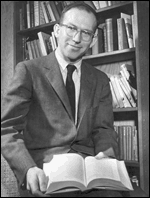 |












|

|

 owers
could not have found a more congenial place to study poetry than postwar
Stanford University, or a more able and sympathetic mentor than Yvor Winters.
Although Bowers had tried his hand at verse when he was a teenager and continued
to write poetry during the war, he had great difficulty finding the forms
to contain his experiences. During and shortly after the war, Bowers tried
to write ambitious, experimental, free-verse poems in the manner of T.S.
Eliot or Hart Crane, but his style was awkward and he sensed that something
was wrong. Reading Yvor Winters's In Defense of Reason led Bowers
to believe that Winters might be able to help him. His first encounter with
Winters, however, began inauspiciously—Bowers asked to be admitted
to Winters's poetry class without a single poem in hand. Winters simply
said, “You look intelligent,” and gave Bowers a chance. Thus began
Bowers's career as one of the foremost poets of the so-called “Stanford
School.” owers
could not have found a more congenial place to study poetry than postwar
Stanford University, or a more able and sympathetic mentor than Yvor Winters.
Although Bowers had tried his hand at verse when he was a teenager and continued
to write poetry during the war, he had great difficulty finding the forms
to contain his experiences. During and shortly after the war, Bowers tried
to write ambitious, experimental, free-verse poems in the manner of T.S.
Eliot or Hart Crane, but his style was awkward and he sensed that something
was wrong. Reading Yvor Winters's In Defense of Reason led Bowers
to believe that Winters might be able to help him. His first encounter with
Winters, however, began inauspiciously—Bowers asked to be admitted
to Winters's poetry class without a single poem in hand. Winters simply
said, “You look intelligent,” and gave Bowers a chance. Thus began
Bowers's career as one of the foremost poets of the so-called “Stanford
School.”
 Bowers
earned his master's degree at Stanford by writing poems, instead of a critical
thesis, under Winters's tutelage; several of these would later appear in
Bowers's first collection of poetry, The Form of Loss (1956). Bowers's
Stanford poems were metrical and often rhymed. They sometimes exhibited
a rational, plain, epigrammatic style similar to that of English Renaissance
poets, such as Fulke Greville and Ben Jonson, whom Winters championed, but
they also exhibited the influences of French poets, such as Leconte de Lisle,
José María de Hérédia, and Paul Val?y. Modern
poets such as Yvor Winters, Allen Tate, and William Butler Yeats—whom Bowers had read on his own in high
school—also could be
heard haunting these elegant poems. After completing his master's degree,
Bowers pursued his doctorate at Stanford, and again, Winters helped Bowers
tremendously, tutoring Bowers so that he could pass his oral examinations. (Having
majored in French and German as an undergraduate, Bowers had not studied
English literature systematically.) Bowers
earned his master's degree at Stanford by writing poems, instead of a critical
thesis, under Winters's tutelage; several of these would later appear in
Bowers's first collection of poetry, The Form of Loss (1956). Bowers's
Stanford poems were metrical and often rhymed. They sometimes exhibited
a rational, plain, epigrammatic style similar to that of English Renaissance
poets, such as Fulke Greville and Ben Jonson, whom Winters championed, but
they also exhibited the influences of French poets, such as Leconte de Lisle,
José María de Hérédia, and Paul Val?y. Modern
poets such as Yvor Winters, Allen Tate, and William Butler Yeats—whom Bowers had read on his own in high
school—also could be
heard haunting these elegant poems. After completing his master's degree,
Bowers pursued his doctorate at Stanford, and again, Winters helped Bowers
tremendously, tutoring Bowers so that he could pass his oral examinations. (Having
majored in French and German as an undergraduate, Bowers had not studied
English literature systematically.)
 Winters
also advised Bowers on his dissertation about the English poet Thomas Sturge
Moore, a friend of William Butler Yeats's. Through Winters and Winters's wife,
the poet and historical novelist Janet Lewis, Bowers became part of a remarkable
circle of Stanford poets, which included J.V. Cunningham and Thom Gunn.
Later Stanford poets, such as Turner Cassity, Helen Pinkerton Trimpi, and
Timothy Steele, also would become Bowers's friends in the art. Among these
peers of poetic tradition, Bowers flourished and excelled. Winters
also advised Bowers on his dissertation about the English poet Thomas Sturge
Moore, a friend of William Butler Yeats's. Through Winters and Winters's wife,
the poet and historical novelist Janet Lewis, Bowers became part of a remarkable
circle of Stanford poets, which included J.V. Cunningham and Thom Gunn.
Later Stanford poets, such as Turner Cassity, Helen Pinkerton Trimpi, and
Timothy Steele, also would become Bowers's friends in the art. Among these
peers of poetic tradition, Bowers flourished and excelled.
 |
  |

Edgar
Bowers's Stanford dissertation
Thomas
Sturge Moore
Yvor
Winters
Letter
from Winters to Bowers, 1956
J.V.
Cunningham
Letter
from Cunningham to Bowers, undated
Typed
MS of "Gods and Men"
Thom
Gunn and Edgar Bowers
Letter
from Gunn to Bowers
Helen
Pinkerton Trimpi
Helen
Pinkerton Trimpi's essay on the poetry of Edgar Bowers in The Southern
Review (Winter, 1977)
Timothy Steele
Excerpt from Timothy Steele's letter to Edgar Bowers (December 18, 1999)
Letter
from Robert Lowell to Bowers, 1964
 THE
POEMS THE
POEMS




"Study
in Reaction," an unpublished poem
"Two
Poems on the Catholic Bavarians: 2"
|

![]()
![]()
![]() THE
POEMS
THE
POEMS![]()
![]()
![]()
![]()
